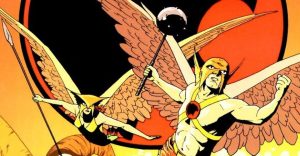The Outsider: 10 Little-Known Facts About The Legend Of “El Cuco”

If you’ve watched HBO’s hit miniseries, The Outsider, you are familiar with “El Cuco.” This shapeshifting monster is able to change its appearance to that of another human being, becoming identical clones of that person. It uses this ability to satisfy its near-unquenchable thirst for human flesh, with children being its preferred delicacy.
The concept of “El Cuco” was not developed by Stephen King, who wrote the novel that the show is based on. This creature’s lore extends back generations and across a huge range of cultures. It seems that every group of people has used “El Cuco,” or a similar type of being, as a learning tool, usually to promote good behavior in children. Here are 10 little-known facts about The Outsider‘s supernatural baddie.
10 Straight Forward Moniker

For many, the legend of “El Cuco” got its start in the area covering Galicia and Portugal. The name translates to coconut, which is often used as a colloquialism referring to a person’s head or skull.
And guess what? That is exactly what this monster is after as it hunts mischievous children, collecting the severed human heads of its victims. Stephen King’s version wasn’t accruing any skulls, but it was certainly looking for children.
9 Alligator/Dragon Monster

The Outsider‘s take on this mythical beast is that of a shapeshifter, who can turn itself into an identical copy of another human being. This is not what the old “Cuco” looked like, though.
In Brazil, which has a similar tradition as the Portuguese/Galician one, this monster has a human-like body, but the scaly head of an alligator or dragon-looking thing. That sounds like quite a sight and probably did the trick when children thought of misbehaving.
8 Don Quixote

Believe it or not, Miguel de Cervantes’s famous novel features a little shout out to “El Cuco.” When Don Quixote dies (spoiler alert), his epitaph refers to him as “el coco del mundo,” or the “El Cuco” of the world.
Don Quixote is considered by many to be the most important piece of fiction ever written. It is a testament to the importance of “El Cuco” that it makes an appearance on the epitaph of arguably the most famous fictional character of all time.
7 Dominican Republic

This legend is particularly prominent in Latin America. While Stephen King’s version of the monster does not have all that many parallels to the myths of Brazil, Portugal, etc., the Dominican iteration is quite similar. In the Dominican Republic, “El Cuco” wanders the streets looking to snatch children who are out after dark.
It is also a shapeshifter, much like in The Outsider. You never really know what form the beast will appear in, making it that much more important to get inside and go to sleep when you’re told.
6 A Monster of Many Names

Although this legend is incredibly popular in South and Central America, whose people generally speak the Romance languages, it has acquired several similar, but slightly different, names. It is often called “El Cuco,” but it could also double as El Coco, Cucuy, Coca, Cucui, Cuca, and more.
Essentially, if there is some way of switching out an a, o, or u, this monster has probably been referred to by that name at one point or another. Can’t everyone just agree on one name to make it easier for people to scare their kids?
5 Tony Ferguson

The Outsider is not “El Cuco’s” only connection to modern pop culture. Tony Ferguson, the mixed martial artist, and former UFC Lightweight Champion, goes by the nickname “El Cucuy.” If you are going for an intimidating nickname, a shapeshifting monster that devours people is certainly a good way to do it.
Ferguson is currently the top contender in his division and has won twelve consecutive fights, which is tied for the lightweight record. It would appear that the image of “El Cucuy” will remain prominent in the world of mixed martial arts.
4 Festa de Coca

The Portuguese people seem to have embraced their supernatural legend. Every year, the Festa de Coca takes places in Monção, a municipality of Portugal. In this festival, a dragon-like structure representing “La Coca” is operated by a few men and pinned to fight against someone representing Saint George.
If Saint George is able to cut off one of the dragon’s ears and it’s tongue, it will be a productive season for the crops and famine will be minimal. However, if the monster scares Saint George’s horse, making him unable to slay her, then the harvest is in for a rough year. Better defeat that Coca, Saint George!
3 Pumpkinhead

As you can tell, the concept of this monster can take many shapes and forms. It can be a dragon, alligator, grim-reaper-looking dude, or just a carbon copy of another human. The Real Academia Española can be viewed as an authority on such things, and they say that “El Cuco” is a ghost whose head is a pumpkin.
Kinda reminds you of the Headless Horseman right? He is a ghost that often uses a pumpkin for a head too. This just goes to show the tremendous influence “El Cuco” has had on other cultures and their fables.
2 Grimm

Before The Outsider, “El Cuco” made appearances in the NBC show, Grimm. The show centers on a detective who is charged with keeping the peace between the real world and the supernatural realm, which features beasts like “El Cuco” (it is known as “El Cucuy” in Grimm).
While this monster is decidedly evil in The Outsider, preying on the innocent, the Grimm version at least seeks out vengeance in the form of devouring evil-doers. Are its methods a bit extreme? Quite. But hey, at least it’s heart was in the right place.
1 Ancient Origins

The idea of “El Cuco” may have picked up steam in Portugal, Spain, Brazil, etc. around the 1500s, but this entity can be traced back thousands of years. Diodorus Siculus, a Greek philosopher born nearly 100 years before the death of Christ, mentioned something similar to “El Cuco” in his writings.
He describes Iberian soldiers serving up offerings to a powerful entity. The offerings came in the form of the severed heads of their enemies. Siculus never explicitly calls it “El Cuco,” but what other supernatural being named after human heads would enjoy skulls as an offering?
About The Author

















